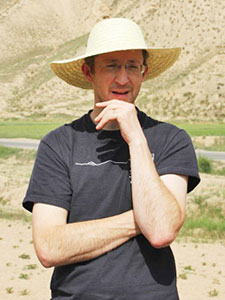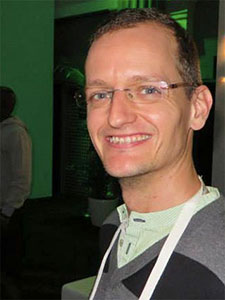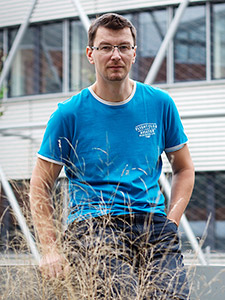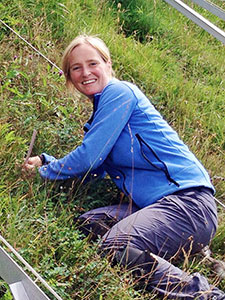Keynote speakers
 Rob Brooker
Rob Brooker
Clonal plants and facilitation research: bridging the gap
Over the last 20 years there has been a substantial increase in interest in plant facilitation – beneficial effects between physiologically isolated neighbouring plants. Beneficial plant-plant interactions are nothing new for researchers working on clonal plants. But despite the obvious links between these two research fields, relatively little work has explicitly considered the links between plant clonality and “classic” facilitation, even though both phenomena are considered more common in some kinds of environment (e.g. arctic and alpine systems). This presentation will define more clearly where areas of overlap between these research fields might lay, and ideas for future research activities that could lead to their greater integration.
The James Hutton Institute, Aberdeen, Scotland, UK
http://www.hutton.ac.uk/staff/rob-brooker
Karl J. Niklas
The keynote talk was unfortunately cancelled because the speaker will not be able to come. We apologize if you were looking forward to this one.
 Rob Salguero-Goméz
Rob Salguero-Goméz
Do selection gradients operate on the genet or the ramet: comparative approach
One of the main tenets
of life history theory is the pervasiveness of trade-offs in the
allocation of limiting resources to reproduction, maintenance and growth.
These trade-offs are fundamental to all of ecology and evolution, as they
restrict the variation in life history strategies that any organism can
display. Yet, the amount of variation in life history theories in the
plant kingdom has recently been quantified to be drastically larger than
previously believed. The quantification of this type of analyses,
impossible up until now due to the lack of the necessary high-resolution,
demographic data, has recently been facilitated through the launching of
the COMPADRE Plant Matrix Database
(www.compadre-db.org). I will discuss how,
drawing for phylogenetic analyses for hundreds of plant species worldwide,
the ability to propagate clonaly drastically unlocks the range of life
history strategies than plants can exhibit, and its implications for basic
research, conservation biology, and ageing research.
The University of Queensland, Australia
Max Planck Institute for Demographic Research, Germany
https://sites.google.com/site/robresearchsite/
Invited speakers
 Katherine L. Gross
Katherine L. Gross
How does clonality contribute to community responses to fertilization?
Clonal plants have long been implicated in declines of species richness and species evenness in fertilized grasslands and it has been hypothesized that the observed decline in species diversity in relation to productivity may be related to the presence of clonal species in the community. Although “clonality” per se may not be predictive of species loss in response to fertilization, the type of clonal growth in combination other traits, particularly height, appears to be predictive of both species and community responses to fertilization. Data from several long-term studies in grasslands in SW Michigan, USA, will be presented to examine how traits of species in a community can determine the magnitude of species loss due to fertilization.
Kellogg Biological Station, Michigan State University, US
http://www.kbs.msu.edu/index.php/people/faculty/gross
 Petr Šmarda
Petr Šmarda
Ecological consequences of genome growth and polyploidy
Vascular plants show over 2300-fold variation in the size of their genomes resulting mainly from activity of retrotransposons and historical or recent polyploidy. Increased genome size has several passive, instant and immediate effects on functioning of plant cells which may substantially affect plant´s morphology, ecology and success in certain environments. These effects include namely increased minimal cell size, prolonged duration of cell cycle and higher DNA-replication associated phosphorus demands. Currently growing data on plant genome sizes, species traits and distribution allows these hypotheses to be robustly tested, further developed and put into new contexts which may significantly improve our understanding of determinants of plant form, function and associated spectra of plant available life-history and ecological strategies. Beyond passive effect of DNA amount, prevalence of some traits and ecological strategies in polyploids (e.g., vegetative reproduction), seem also due to their selection during establishment of polyploids in the population of their diploid parent(s). Here I will briefly summarize the current theory and some new hypotheses on the effect of genome size and polyploidy on species ecology and distribution and provide examples of these effects from our ongoing research of genome size variation in the Czech flora and the data from CLOPLA database of clonal plant traits.
Masaryk University, Brno, CZ
http://www.sci.muni.cz/botany/systemgr/index.php?show=people&who=smarda
 Philippine Vergeer
Philippine Vergeer
The ecological and evolutionary
relevance of environmentally induced non-genetic transgenerational effects
The heritability of environment-induced non-genetic effects is currently a
topic of great interest in plant biology and ecology. We know that
heritable adaptive responses to the environment may also evolve from
variation in epigenetic modifications of the genome, even in the absence
of DNA sequence variation. Such epigenetic processes may therefore provide
an important and versatile additional mechanism for plants to rapidly adapt to environmental change. However many of these environment-induced transgenerational effects are context dependent and are therefore often
dismissed as noise. Consequently the interpretation of its ecological and
evolutionary relevance is difficult. Here I present a unique study in
which we compare plant responses to exposure of different environments
over single and multiple generations. Effects of ancestral environments
were detectable in all traits and in all environments, but the magnitude
and direction differed between offspring environments. In addition,
different responses to a common stress factor were found, depending
whether the stress factor was applied in a single generation or over
multiple generations. The results imply that transgenerational effects
commonly occur and may have a considerable impact on plant phenotype,
plant performance and the way plants respond to their environment. The
role of epigenetic inheritance as a prime mechanism for these observed transgenerational effects will be discussed.
Nature Conservation and Plant Ecology Group, Wageningen University, NL
http://www.wageningenur.nl/en/Persons/dr.-P-Philippine-Vergeer.htm
http://www.ru.nl/molecularecology/people/philippine-vergeer/
